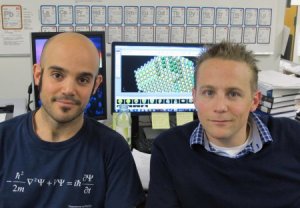University of Oregon and industry researchers have partnered together to identify imperfections and help improve nanomaterial quality. The improved nanomaterials could be used in the next-generation of solar cells.
 UO doctoral student Christian Gervasi, left, and Thomas Allen of VoxtelNano
UO doctoral student Christian Gervasi, left, and Thomas Allen of VoxtelNano
Manufacturers have made use of chemically synthesized semiconductor nanocrystal layers to improve light-harvesting efficiency of solar cells beyond silicon’s 29% limit. Quantum dot characteristics can be manipulated by controlling the surface chemical structure and the synthetic process. However, this technique may result in imperfections at the surface-forming trap states, limiting device performance.
In this study, researchers used a scanning tunnelling microscope exclusively designed for this purpose and developed atomic-scale maps of the state density in each nanocrystal.
By this, they were able to specify the energies and charge trap localization related to defects in the structure of the nanocrystal harmful to propagation of electrons.
The microscope design was developed in George V Nazin, a co-author’s lab, who is also a professor in the UO Department of Chemistry and Biochemistry.
The researchers wanted to see what the microscope was capable of and it offers data on the trap states and depth of trap states in the quantum dots. This data would help fine-tune the ligand chemistry in order to make sophisticated devices for detectors, photovoltaics and sensors.
We want to use these materials in real devices, but they are not yet optimized.
co-author Christian F. Gervasi, a UO doctoral student
The trap states observed in the microscope show why solar cells based on nanoparticles have not been commercialized.
Nanoparticles are not stable always. While synthesizing at the nanoscale, the same structure is not obtained for all quantum dots. Large variations in the electronic states can be obtained while working at the atomic scale. This too helps to observe these states directly and help offer feedback on the materials.
Voxtel Nanophotonics synthesized the quantum dots and Sony supported the research.
References and Further Reading